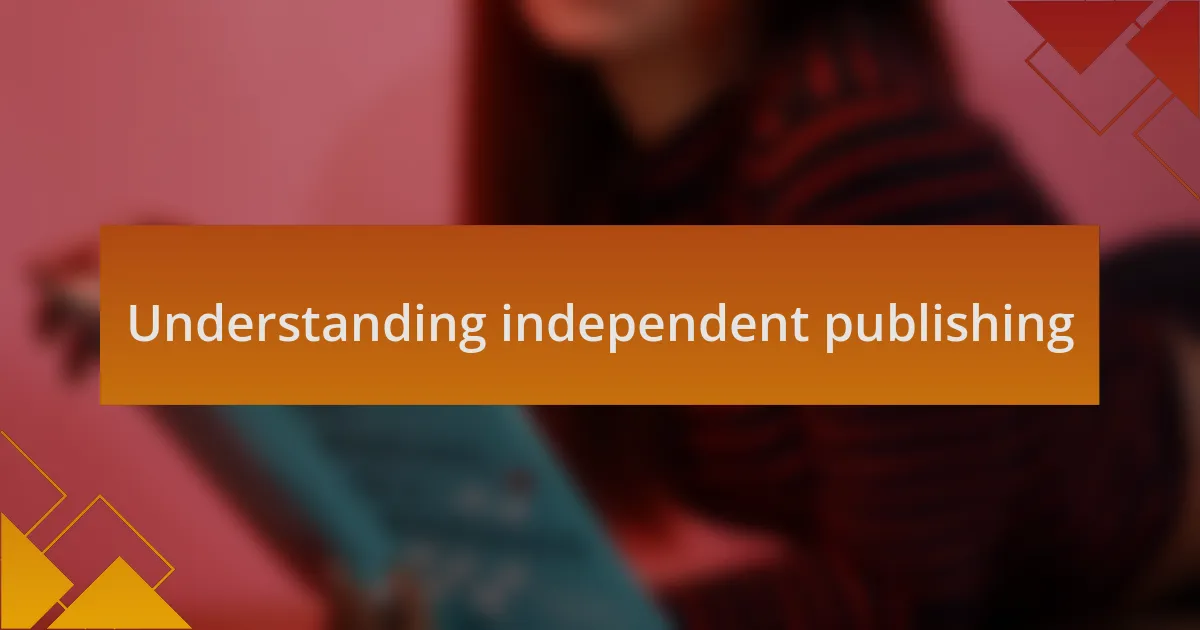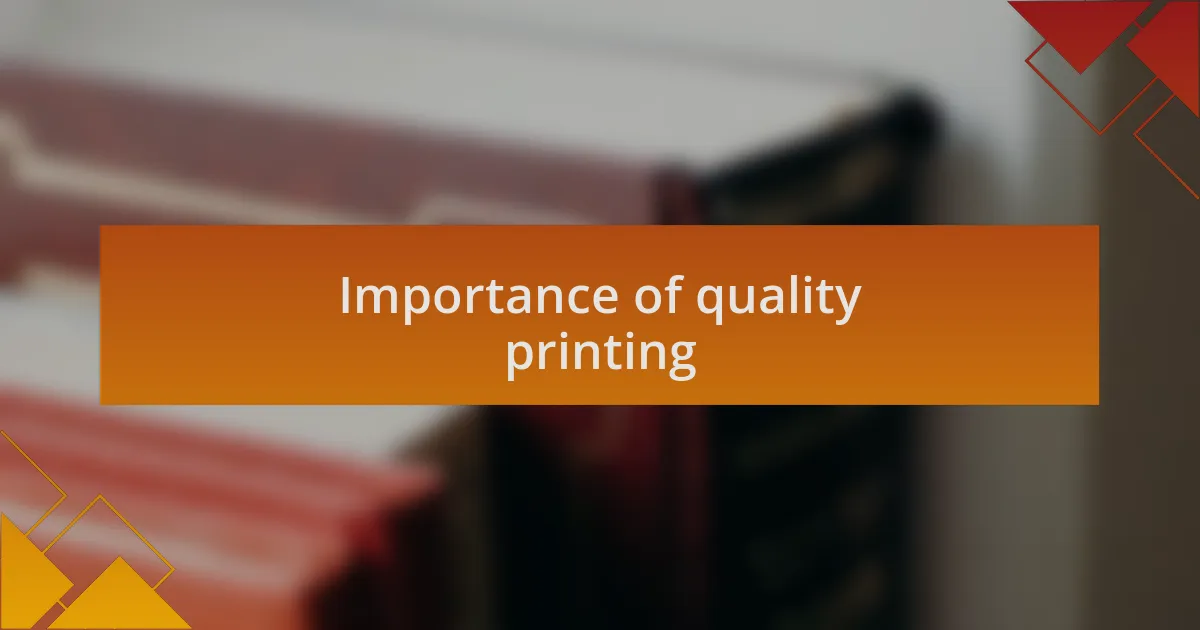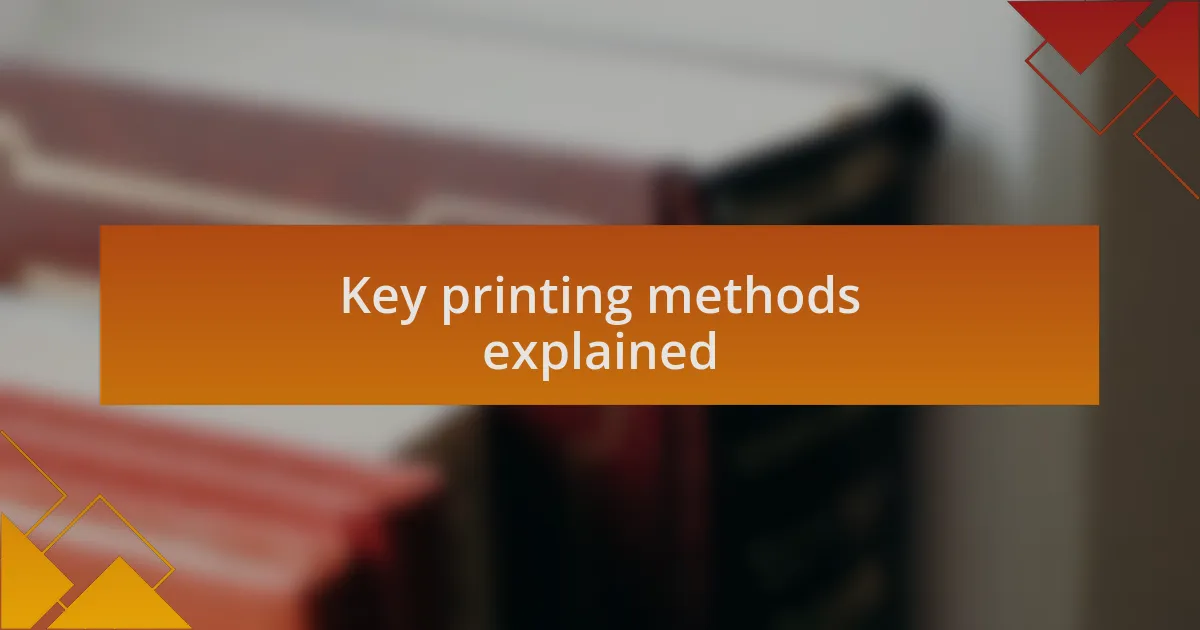Key takeaways:
- Independent publishing empowers authors by allowing full control over their work while fostering a supportive community.
- Quality printing significantly influences how a book is perceived and reflects an author’s respect for the reader.
- Different printing methods cater to specific needs, with digital, offset, and letterpress offering unique advantages and aesthetics.
- Selecting the right paper type enhances the storytelling experience, affecting both the look and feel of the finished product.

Understanding independent publishing
Independent publishing represents a shift from traditional routes, allowing creators to hold the reins of their work. I can still recall the exhilaration I felt the first time I decided to publish a book on my own. It was empowering to know that I crafted every aspect—from writing and design to marketing—without needing to fit into someone else’s mold.
What really struck me was the sense of community in the independent publishing world. I often found myself exchanging tips with other authors, sharing our trials and triumphs. This collaboration not only enriched my understanding of the process but also highlighted an unspoken question: How much value do we place on the shared experiences of others in this journey?
Delving deeper, I learned that independence in publishing isn’t just about control; it’s about authenticity. Each author’s voice shines through without being diluted by outside influences. Have you ever felt that your true message was being overlooked? In independent publishing, I discovered a space where transparency and originality are celebrated, paving the way for genuine connections with readers.

Importance of quality printing
Quality printing is often the unsung hero of independent publishing, playing a crucial role in how a book is perceived. I remember the moment I held my first printed manuscript; the tactile feel of quality paper and crisp ink made a significant impression. How can one underestimate the impact of that first glance? It sets the tone for the entire reading experience.
I’ve seen firsthand how a well-printed book can elevate an author’s work. When I released my latest title, I opted for high-quality finishes—the kind that catches the light just so and makes the cover pop. The reaction from readers was overwhelmingly positive, emphasizing how a polished exterior can reflect the depth of the content inside. It leads me to wonder, what message are we sending to our audience when we skimp on printing quality?
In my journey through independent publishing, I’ve learned that quality printing isn’t just about aesthetics; it’s about respect for the reader. Each time I invest in better materials, I’m signaling to my audience that I value their experience. Reflecting on my choices, I often ask myself, are we truly committed to our craft if we overlook such fundamental details? Ultimately, I believe that quality in printing speaks volumes about our dedication to the art of storytelling.

Key printing methods explained
When considering printing methods, I’ve discovered that each approach has its unique advantages and limitations. For instance, digital printing is fantastic for short runs and variable data, allowing me to print just what I need without the overhead costs. I’ll never forget the thrill of using digital printing for my first limited edition; the ability to customize each book cover felt like crafting a personal gift for my readers.
Then there’s offset printing, which I’ve often relied on for larger quantities. It offers exceptional quality and vibrancy that digital just can’t match. I recall working with a small printing press that introduced me to offset techniques; the moment I saw that vibrant ink on the page, I knew I had made the right choice for my project. Have you ever experienced that moment of revelation when the result exceeds your expectations?
Another method worth noting is letterpress, which has a distinct charm that resonates with the tactile experience I love to create in publishing. It may take longer and cost more, but the embossed design adds a beautiful depth that enhances the reader’s connection to the book. I find myself wondering: isn’t it these small, exquisite details that make our work truly stand out in a saturated market?

Selecting the right paper types
When it comes to selecting the right paper type for your printing project, the choice can significantly affect both the look and feel of your work. I remember the first time I chose a textured paper for a poetry collection; the tactile experience added a layer of intimacy that my readers truly appreciated. Have you ever considered how the weight and finish of the paper could evoke emotions tied to your content?
For example, if you’re publishing a children’s book, opt for a heavier, glossy paper that enhances colors and images, drawing young readers in visually. I once printed a vibrant anthology of illustrations on a satin finish, and the way the colors popped off the pages added a magical touch that children couldn’t resist. It made me realize that the right paper type isn’t just a technical choice; it’s an integral part of the storytelling experience.
On the other hand, if your project leans towards a classic aesthetic, uncoated or matte papers may serve you well. I once experimented with uncoated paper for a literary magazine, allowing words to take center stage. The subtle, natural finish felt genuine and reliable, aligning perfectly with the tone of the pieces we featured. Have you ever picked a paper that just felt right in your hands and matched your content’s essence? That’s the kind of decision that can elevate your publishing game.

Pricing strategies for printing
Pricing your printing projects effectively can be daunting, but I’ve found that understanding the costs involved can make the process smoother. In my experience, I’ve learned to break down expenses into categories—like materials, labor, and overhead—so I can accurately gauge the final price. Have you ever tried using a simple spreadsheet to itemize these factors? It not only clarifies your budget but also helps you adjust your pricing strategy based on the specifics of each project.
When I first ventured into printing my own book, I underestimated the impact that quantity could have on pricing. I discovered that ordering in bulk significantly reduced my per-unit cost, which allowed me to offer a more competitive price. It made me wonder—are most independent publishers aware of how printing volume can influence their profits? I believe more dialogue around this topic could empower authors to make informed choices that better support their projects.
Another strategy I’ve adopted involves pricing based on market research, which has been invaluable. Analyzing what similar publications charge can help you find the sweet spot for your own pricing. I remember consulting pricing guides and even reaching out to local publishers for insights. Have you ever considered such direct interactions? Establishing a relationship with your printing vendor can not only provide you with pricing insights but often leads to better deals that benefit you in the long run.